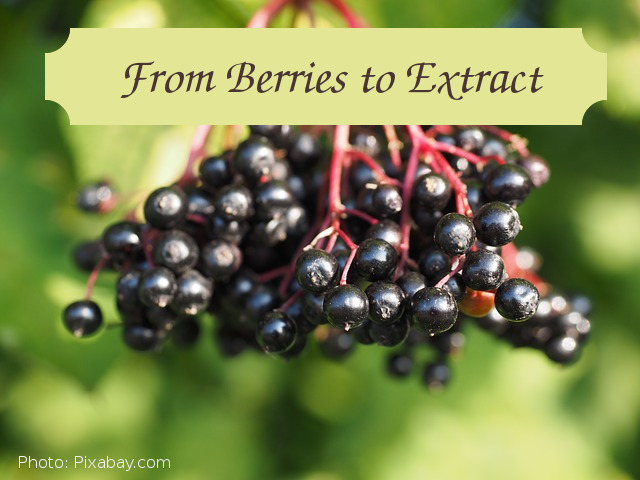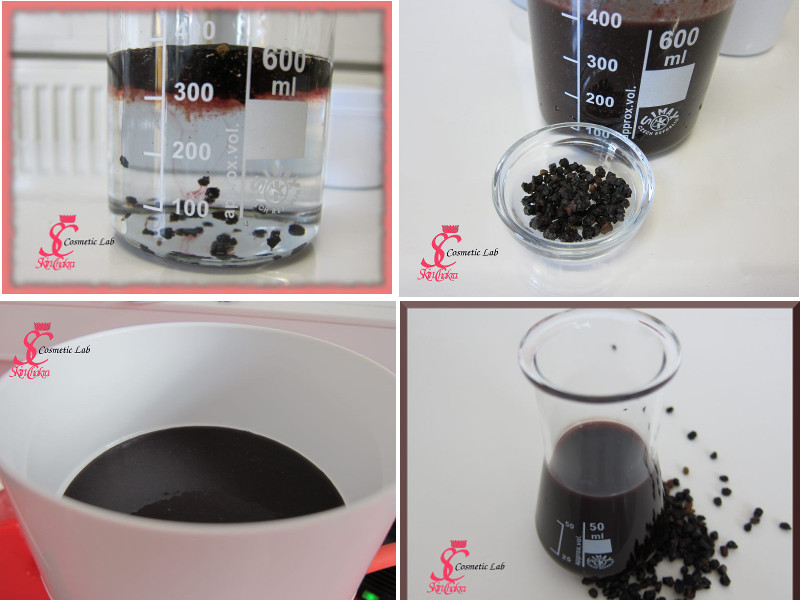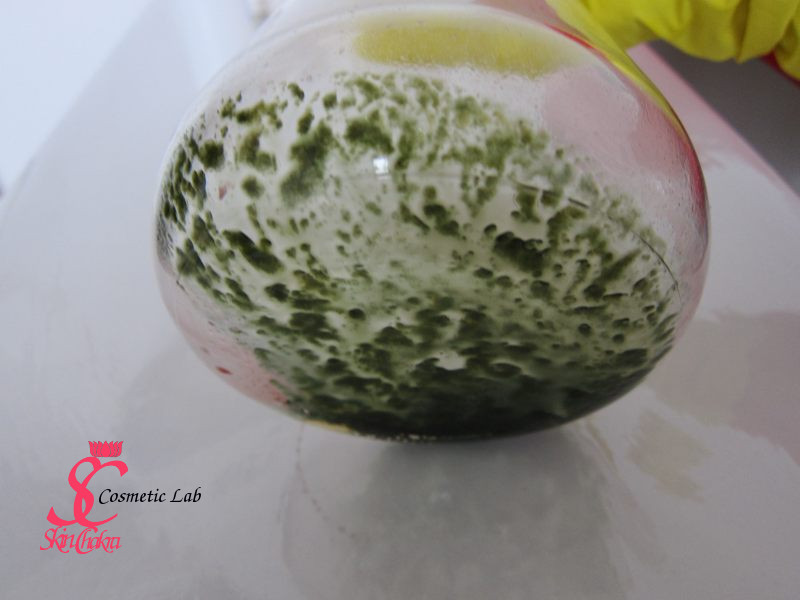
Samstag, 27. Februar 2016
From Berries to Extract

One of the most amazing activities in the cosmetic lab is preparation of herbal infusions, macerated oils and extracts.
I've dedicated a couple of days to preparing extracts which I'm going to use in some of my upcoming formulations.
By working with extracts, one should always consider the difference between different extract types and the difference between an extract and an infusion or a macerated oil. This is one of the most frequently asked question in every formulation course and most of the students become really confused among different types of extracts and infusions and unfortunately often end up with applying a water soluble extract in an oil or vice versa.
Extraction vs. infusion
You need a carrier for both extraction and infusion. By infusion, you add your plant material to water (usually hot or boiling water) or to an oil (this is rather called a macerated oil than infusion). For water based infusions, the infusion time is ratehr short, from a few minutes to hald an hour. By oil infusion (macerated oils) you may apply hot, warm or cold infusion. Obviously the higher the temperature, the shorter the time needed.
It is clear that in water-based infusions, you generally extract or gain water soluble components of the herb and by oil infusions, you gain the oil soluble or lipophilic component. This is something you need to consider before even planning your infusion.
In extraction, you do pretty much the same only under other conditions and to a greater extent. One shall consider an extract as an infusion with 10-20 times more active ingredients.
Extraction can be performed both cold and hot, with volatile solvents or with fixed solvents. Most of the industrial extractions were, and are carried on with volatile solvents in a continuous and repetitive way. It means a solvent (or blend of solvents) is run several times through the herbs in repetitive cycles. At the end of the extraction, the solvent is distilled and gathered for further applications. Most widely applied solvents are hexane and acetone. The extracted material could then be completely dried or could be redissolved in another carrier. This method was widely used an is still used in oil extraction from seeds and nuts because of its efficacy, low price and high yield. It is however not acceptable in "organic cosmetics".
Just like infusion, you shall consider which active ingredients you want to extract and accordingly choose your carrier before running any extraction. For water soluble and polar material extraction you'll obviously need a polar solvent, for oil soluble ingredients you'll need a lipophilic and non-polar carrier.
Water sounds a very nice and natural (available and cheap) carrier for polar material. the problem is however, that water is not a very good extractor on its own. This is why hydrophilic extracts on the markert are either offered in propylene glycol-water blend (hydroglycolic) or in glycerine-water blend (hydroglyceric). Propylene glycol is a much better solvent than glycerine, however the mineral oil based propylene glycol is a no-go in "natural" & "organic" cosmetics.
With the availability of plant-based propane-diol, it is possible to have effective, plant based and organic hydrophilic extracts. Plant based propane-diol is however, not quite affordable and available at the moment (at least not for home extraction).
If you happen to stumble upon a hydroglycolic extract, ask your supplier about the origin of their propylene glycol or propane-diol if you want to keep your roducts natural & organic.
Glycerine is quite an affordable "natural" and "organic" solvent. However, as I mentioned before, it is not as good as propane-diol. This is where we have to sacrifice some active matter in order to keep the product "natural".
To extract "lipophilic" ingredients such as oil soluble vitamins, phytosterols etc, you'll need a lipophilic solvent. Theoretically you can apply any oil of your choice or even caprylic/capric triglyceride for your extraction. To make a reasonable extract however, you'll need a carrier with a low inherent scent and colour, a medium to low viscosity and a reasonable shelf-life. Sunflower oil, jojoba oil and almond oil are those most widely applied (besides caprylic/capric triglycerides). I have even prepared extracts in castor oil for a certain lipstick project.
Extraction methods
With extraction, you usually break the cell walls and get into the inner of the plant cells. This is the main difference between extraction and infusion. To break the cells you can apply heat (the least suitable method because you're destroying heat-sensitive ingredients), mechanical agitation or ultrasound energy. Since both mechanical agitation and ultrasound energy can cause heat, you have to cool the blend during extraction. I usually use an ice-water bath to avoid heating the blend during extraction.
Filtration
This is the most trifling and time consuming part of the whole job. Usually you want to get as much as possible out of your extracts. The simples (but not the most effective and most hygienic) method is the old cheese-cloth method. I usually run 3-4 filtration steps starting from a very coarse sieve and moving step by step to finer filters.

Preservation
After investing so much time and effort in preparing your extracts, your worst nightmare would be a contamination.
Hydrophobic extracts (oil soluble) do not need any preservative because there is no water to cause any contamination. Makes sure that your plant parts are completely dry before starting any extraction of infusions. even the slightest amount of moisture can cause contamination. If however you observe any turbisity which might be cause by moisture after filtering your material, do not discard the extract. Have a look at this link to know how to cure your extract and save it from contamination.
Your oils soluble extracts however, need some anti-oxidants to prolong the shelf-life of the oil and avoid rancisity. If your oil already contains any anti-oxidant, there is no need for additional anti-oxidants, if the oil is free of anti-oxidants, it is better to add a rosemary CO2 extract or Vit E to protect your extract against oxidation.
Water soluble carriers should be preserved against contamination. Usually high concentrations of glycol and glycerine make a self-preserving system and avoid contamination. I personally prefer to add a preservative to my extracts. If you know that you're going to use the extract in a very short time in a finished product, you may decide to fill your extract in sterile bottles and go ahead without any added preservative.
I recommend however to reduce the pH of the extract and to add a chelator to reduce the risk of contamination. (keep in mind that pH reduction, chelator or filling the extract in sterile bottles are not comparable with adding any preservative, these are complementory and temporary methods)
Storage
Extracts should not necessarily be stored in a fridge. It's enough to keep them in dark and well closed bottles, protected from light and moisture and keep them in a cool place. Use a suitable bottle according to the volume of the extract. The bigger the bottle size, the higher the headspace volume as the contents are reduced. This promotes rancidity and microbial contamination.
I'm going to share some recipes with this beautiful elderberry extract in the coming weeks. I've applied a 60:40 mixture of organic glycerine and water for extraction and extracted dries elderberries. After extraction and filtration I reduced the pH to 4.5 and added a suitable preservative (sodium anisate, sodium benzoate blend).
My hands were itching to immediately apply this beauty in a soap but knowing that anthocyanin color is pH dependant, I knew that this beautiful dark red colour would change to a blue-green colour as soon as the pH is increased.

Thanks for your visit. Keep an eye for the upcoming recipes.

